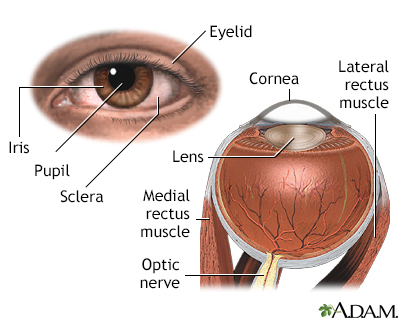Photophobia
Definition
Photophobia is eye discomfort in bright light.
Alternative Names
Light sensitivity; Vision - light sensitive; Eyes - sensitivity to light
Considerations
Photophobia is common. For many people, the problem is not due to any disease. Severe photophobia may occur with eye problems. It can cause bad eye pain, even in low light.
Causes
Causes may include:
- Acute iritis or uveitis (inflammation inside the eye)
- Burns to the eye
- Corneal abrasion
- Corneal ulcer
- Drugs such as amphetamines, atropine, cocaine, cyclopentolate, idoxuridine, phenylephrine, scopolamine, trifluridine, tropicamide, and vidarabine
- Excessive wearing of contact lenses, or wearing poorly-fitting contact lenses
- Eye disease, injury, or infection (such as chalazion, episcleritis, glaucoma)
- Eye testing when the eyes have been dilated
- Meningitis
- Migraine headache
- Recovery from eye surgery
Home Care
Things you can do to ease light sensitivity include:
- Avoid sunlight
- Close your eyes
- Wear dark glasses
- Darken the room
If eye pain is severe, see your health care provider about the cause of light sensitivity. Proper treatment may cure the problem. Get medical help right away if your pain is moderate to severe, even in low-light conditions.
When to Contact a Medical Professional
Call your provider if:
- Light sensitivity is severe or painful. (For example, you need to wear sunglasses indoors.)
- Sensitivity occurs with headaches, red eye or blurred vision or does not go away in a day or two.
What to Expect at Your Office Visit
The provider will perform a physical exam, including an eye exam. You may be asked the following questions:
- When did the light sensitivity begin?
- How bad is the pain? Does it hurt all the time or just sometimes?
- Do you need to wear dark glasses or stay in dark rooms?
- Did a doctor recently dilate your pupils?
- What medicines do you take? Have you used any eye drops?
- Do you use contact lenses?
- Have you used soaps, lotions, cosmetics, or other chemicals around your eyes?
- Does anything make the sensitivity better or worse?
- Have you been injured?
- What other symptoms do you have?
Tell your provider if you have any of these symptoms:
- Pain in the eye
- Nausea or dizziness
- Headache or neck stiffness
- Blurred vision
- Sore or wound in eye
- Redness, itching, or swelling
- Numbness or tingling elsewhere in the body
- Changes in hearing
The following tests may be done:
- Corneal scraping
- Lumbar puncture (most often done by a neurologist)
- Pupil dilation
- Slit-lamp exam
Gallery

References
Ghanem RC, Ghanem MA, Azar DT. LASIK complications and their management. In: Azar DT, ed. Refractive Surgery. 3rd ed. Philadelphia, PA: Elsevier; 2020:chap 15.
Lee OL. Idiopathic and other anterior uveitis syndromes. In: Yanoff M, Duker JS, eds. Ophthalmology. 5th ed. Philadelphia, PA: Elsevier; 2019:chap 7.20.
Olson J. Medical ophthalmology. In: Ralston SH, Penman ID, Strachan MWJ, Hobson RP, eds. Davidson's Principles and Practice of Medicine. 23rd ed. Philadelphia, PA: Elsevier; 2018:chap 27.